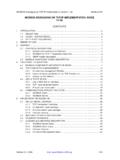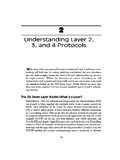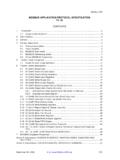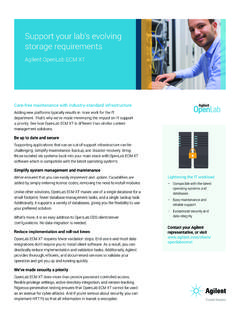Transcription of Network Design - Texas A&M University at Galveston
1 3 Network DesignBefore purchasing equipment or deciding on a hardware platform, you should have a clear idea of the nature of your communications problem. Most likely, you are reading this book because you need to connect computer networks together in order to share resources and ultimately reach the larger global Internet. The Network Design you choose to implement should fit the commu-nications problem you are trying to solve. Do you need to connect a remote site to an Internet connection in the center of your campus? Will your Network likely grow to include several remote sites? Will most of your Network com-ponents be installed in fixed locations, or will your Network expand to include hundreds of roaming laptops and other devices?In this chapter, we will begin with a review of the networking concepts that define TCP/IP, the primary family of networking protocols currently used on the Internet.
2 We will then see examples of how other people have built wire-less networks to solve their communication problems, including diagrams of the essential Network structure. Finally, we will present several common methods for getting your information to flow efficiently through your Network and on to the rest of the 101 TCP/IP refers to the suite of protocols that allow conversations to happen on the global Internet. By understanding TCP/IP, you can build networks that will scale to virtually any size, and will ultimately become part of the global you are already comfortable with the essentials of TCP/IP networking (in-cluding addressing, routing, switches, firewalls, and routers), you may want 27to skip ahead to Designing the Physical Network on Page 51. We will now review the basics of Internet , Italy is a fantastic city to get lost in. The roads are mere foot paths that cross water in hundreds of places, and never go in a simple straight line.
3 Postal carriers in Venice are some of the most highly trained in the world, specializing in delivery to only one or two of the six sestieri (districts) of Ven-ice. This is necessary due to the intricate layout of that ancient city. Many people find that knowing the location of the water and the sun is far more useful than trying to find a street name on a : Another kind of Network mask. Imagine a tourist who happens to find papier-m ch mask as a souvenir, and wants to have it shipped from the studio in S. Polo, Venezia to an office in Seattle, USA. This may sound like an ordinary (or even trivial) task, but let's look at what actually artist first packs the mask into a shipping box and addresses it to the office in Seattle, USA. They then hand this off to a postal employee, who at-taches some official forms and sends it to a central package processing hub for international destinations.
4 After several days, the package clears Italian customs and finds its way onto a transatlantic flight, arriving at a central im-port processing location in the Once it clears through customs, the package is sent to the regional distribution point for the northwest , then on to the Seattle postal processing center. The package eventually makes its way onto a delivery van which has a route that brings it to the proper ad-dress, on the proper street, in the proper neighborhood. A clerk at the office 28 Chapter 3: Network Designaccepts the package and puts it in the proper incoming mail box. Once it ar-rives, the package is retrieved and the mask itself is finally clerk at the office in Seattle neither knows nor cares about how to get to the sestiere of S. Polo, Venezia. His job is simply to accept packages as they arrive, and deliver them to the proper person. Similarly, the postal carrier in Venice has no need to worry about how to get to the correct neighborhood in Seattle.
5 His job is to pick up packages from his local neighborhood and for-ward them to the next closest hub in the delivery 10 of 1 of 10 Figure : Internet networking. Packets are forwarded between routers until they reach their ultimate destination. This is very similar to how Internet routing works. A message is split up into many individual packets, and are labeled with their source and destination. The computer then sends these packets to a router, which decides where to send them next. The router needs only to keep track of a handful of routes (for example, how to get to the local Network , the best route to a few other local networks, and one route to a gateway to the rest of the Internet). This list of possible routes is called the routing table. As packets arrive at the router, the destination address is examined and compared against its internal routing table. If the router has no explicit route to the destination in question, it sends the packet to the closest match it can find, which is often its own Internet gateway (via the default route).
6 And the next router does the same, and so forth, until the packet eventually arrives at its can only make their way through the international postal system be-cause we have established a standardized addressing scheme for packages. For example, the destination address must be written legibly on the front of the package, and include all critical information (such as the recipient's name, Chapter 3: Network Design 29street address, city, country, and postal code). Without this information, pack-ages are either returned to the sender or are lost in the can only flow through the global Internet because we have agreed on a common addressing scheme and protocol for forwarding packets. These standard communication protocols make it possible to exchange in-formation on a global communicationsCommunication is only possible when the participants speak a common lan-guage. But once the communication becomes more complex than a simple conversation between two people, protocol becomes just as important as language.
7 All of the people in an auditorium may speak English, but without a set of rules in place to establish who has the right to use the microphone, the communication of an individual s ideas to the entire room is nearly impossi-ble. Now imagine an auditorium as big as the world, full of all of the comput-ers that exist. Without a common set of communication protocols to regulate when and how each computer can speak, the Internet would be a chaotic mess where every machine tries to speak at have developed a number of communications frameworks to address this problem. The most well-known of these is the OSI OSI modelThe international standard for Open Systems Interconnection (OSI) is de-fined by the document ISO/IEC 7498-1, as outlined by the International Standards Organization and the International Electrotechnical Commission. The full standard is available as publication "ISO/IEC 7498-1:1994," available OSI model divides Network traffic into a number of layers.
8 Each layer is independent of the layers around it, and each builds on the services provided by the layer below while providing new services to the layer above. The ab-straction between layers makes it easy to Design elaborate and highly reli-able protocol stacks, such as the ubiquitous TCP/IP stack . A protocol stack is an actual implementation of a layered communications framework. The OSI model doesn't define the protocols to be used in a particular Network , but simply delegates each communications "job" to a single layer within a well-defined the ISO/IEC 7498-1 specification details how layers should interact with each other, it leaves the actual implementation details up to the manu-facturer. Each layer can be implemented in hardware (more common for lower layers) or software. As long as the interface between layers adheres to 30 Chapter 3: Network Designthe standard, implementers are free to use whatever means are available to build their protocol stack .
9 This means that any given layer from manufacturer A can operate with the same layer from manufacturer B (assuming the rele-vant specifications are implemented and interpreted correctly).Here is a brief outline of the seven-layer OSI networking model:LayerNameDescription7 ApplicationThe Application Layer is the layer that most net-work users are exposed to, and is the level at which human communication happens. HTTP, FTP, and SMTP are all application layer protocols. The human sits above this layer, interacting with the Presentation Layer deals with data representa-tion, before it reaches the application. This would include MIME encoding, data compression, format-ting checks, byte ordering, etc. 5 SessionThe Session Layer manages the logical communica-tions session between applications. NetBIOS and RPC are two examples of a layer five Transport Layer provides a method of reaching a particular service on a given Network node.
10 Exam-ples of protocols that operate at this layer are TCP and UDP. Some protocols at the transport layer (such as TCP) ensure that all of the data has arrived at the destination, and is reassembled and delivered to the next layer in the proper order. UDP is a "con-nectionless" protocol commonly used for video and audio streaming. 3 NetworkIP (the Internet Protocol) is the most common Net-work Layer protocol. This is the layer where routing occurs. Packets can leave the link local Network and be retransmitted on other networks. Routers perform this function on a Network by having at least two Network interfaces, one on each of the networks to be interconnected. Nodes on the Internet are reached by their globally unique IP address. Another critical Network Layer protocol is ICMP, which is a special protocol which provides various management messages needed for correct operation of IP.









